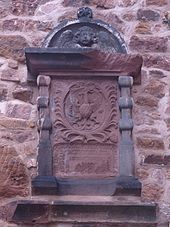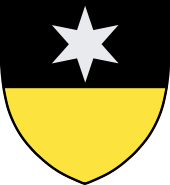Ziegenhain (noble family)
The Counts of Ziegenhain come from the family of the Counts of Reichenbach . Since 1144 at the latest, they have been called " Counts of Cigenhagen " after the Ziegenhain castle built by Gottfried I. Occasionally from 1144 to 1220 they also called themselves Counts von Wegebach , a settlement 1 km north of Ziegenhain, first mentioned in a document in 1144 and named "villa" in 1308, in which Gottfried I initially resided and which became deserted around the end of the 15th century .
history
In the 12th century, the Counts of Ziegenhain built a rulership between Burgwald and Knüll , the county of Ziegenhain , whose territory almost completely separated Niederhessen from Upper Hesse , on the basis of a bailiwick over the Fulda monastery and from Allod property , Reichsgut and Mainzer , Fulda and Hersfeld fiefs . The bailiwick of the Fulda Monastery was owned by the family for the first time with Gozmar I. and became hereditary.
Gozmar III. († 1184) married his daughter Luckardis to Friedrich von Thuringia , the third son of the Ludowinger Landgrave Ludwig II of Thuringia. This marriage gave rise to considerable difficulties, as Friedrich now made claims to the county of Ziegenhain. The dispute ended in 1233 with a contract.
As early as 1205, Ludwig I inherited the county of Nidda in the northern Wetterau as the nephew of the last Count of Nidda , Berthold II , who died without a male heir. This was based in the core on a bailiwick over possession of the Fulda monastery in this area. In May 1344 Count Johann I sold all the remaining rights of the Fulda Bailiwick to the abbey itself for 7,100 pounds of Heller , which, after the payment of the entire purchase price in 1346, finally resolved this connection. However, the counts retained the hereditary office of the Fulda marshal , whose duties included the jurisdiction over the Fulda knighthood, the presidency of state parliaments and the command of the feudal nobility and the ministerials .
Ludwig I was a member of the Staufer partisans . His presence in the vicinity of Philip of Swabia is documented several times: 1205 in Nuremberg , 1206 in Boppard , 1207 in Jülich and in the same year at the farm day in Gelnhausen . Together with other relatives, he donated the Reichenbach Monastery to the Teutonic Order in 1207 . The youngest son of Ludwig I, Burkhart von Ziegenhain , held numerous ecclesiastical dignities and finally became Archbishop of Salzburg in 1247 . His two older brothers, Gottfried IV and Berthold I, rule the counties of Ziegenhain and Nidda together, but their sons divided the country: Ludwig II received the county of Nidda, in which his son Engelbert I succeeded, and Gottfried V. the county of Ziegenhain, which he gave his son Gottfried VI. inherited. In 1330 the two parts of the country were reunified after Johann I von Ziegenhain, son of Gottfried VI, married the heiress Lukardis (Luitgart) of the last Nidda count from the house of Ziegenhain, Engelbert I, in 1311.
The last Count of Ziegenhain, Johann II. ("The Strong"), died in 1450 without a male heir, which led to a long and bitter dispute between the two potential legal successors, Landgrave Ludwig I of Hesse and the House of Hohenlohe . The inheritance dispute lasted until 1495 and ended with the victory of Hesse. The Hohenloher received a severance payment of 9,000 guilders, continued to use the six-pointed Ziegenhainer star in their coat of arms and retained the coveted title of count. From that time on, the House of Hesse had the title "Count of Ziegenhain, Count of Nidda".
Well-known members of the Ziegenhain family
- Gottfried I († 1168), founder of the Ziegenhain family
- Gozmar III. († 1184), son and successor of Gottfried I, victim of the Erfurt latrine fall
- Burkhart von Ziegenhain († 1247), 1240 provost of Fritzlar , 1247 archbishop of Salzburg
- Johann I († 1359), Count of Ziegenhain and Nidda
- Gottfried VII. († 1372), Count of Ziegenhain and Nidda, captain of the Star League
- Gottfried VIII. († 1394), Count of Ziegenhain and Nidda, captain of the Star League
- Otto († 1430), 1419–1430 Archbishop of Trier
- Johann II. († 1450), Otto's brother, last of his house
coat of arms
The coat of arms of the counts adorned the goat head eagle until 1350 , later a six-pointed silver star in a shield divided into black and gold (yellow).
The goat head eagle was preserved as a crest ornament : On the helmet with black and gold covers a growing silver armored black billy goat between a flight tinged like the shield and each with a silver six-pointed star . In the past, the crest was also depicted as a winged, growing billy goat. For example on the grave slab of Count Johann I of Ziegenhain († 1359) in the church of the former Cistercian monastery Haina .
The goat head eagle has remained a defining part of the city arms in the area of the former county of Ziegenhain (e.g. Neukirchen or Schwarzenborn ) up to the present day .
literature
- Karl E. Demandt: History of the State of Hesse, 2nd edition, Kassel, 1972 (pp. 203-207, Grafschaft Nidda: p. 159) ISBN 3-7618-0404-0 .
- Gerhard Köbler : Historical lexicon of the German countries. The German territories from the Middle Ages to the present. 7th, completely revised edition. CH Beck, Munich 2007, ISBN 978-3-406-54986-1 .
- Martin Röhling: The history of the counts of Nidda and the counts of Ziegenhain = Niddaer Geschichtsblätter 9. Ed .: Niddaer Heimatmuseum eV Nidda, 2005. ISBN 3-9803915-9-0 .
- H. Römer: "On the constitutional history of the county of Ziegenhain in the 13th and 14th centuries". In the journal of the Association for Hessian History and Regional Studies 48 (1915), pp. 1–118.
- Gerhard Taddey : "How the Hohenlohe Counts were". In: Contributions to regional studies. Regular supplement to the State Gazette for Baden-Württemberg 5 (1976), pp. 1-9.
- Friedrich-Wilhelm Witzel: The Reichsabtei Fulda and their high bailiffs, the counts of Ziegenhain in the 12th and 13th centuries = Publication of the Fuldaer Geschichtsverein 41 (1963).
Web links
Individual evidence
- ^ Friedrich Karl zu Hohenlohe-Waldenburg: Hohenlohe. Pictures from the history of house and country. 4th edition. Family Association of the Princely House of Hohenlohe, Öhringen 1983. p. 15; Gerhard Taddey: "How the Hohenlohe Counts were". In: Contributions to regional studies. Regular supplement to the state gazette for Baden-Württemberg. No. 5, 1976 (pp. 1-9).
- ↑ Eckhart Franz, Kloster Haina, Regesten und Urkunden, first volume: 1144-1300, Marburg 1962, No. 50, 117, 293 and 695. Second volume: 1300-1560, 1st half, Marburg 1970, No. 475 and 590 .
- ↑ Bernhard Peter, Gallery: Photos of beautiful old coats of arms No. 11: coat of arms in the Philippsburg in Braubach am Rhein AD 1568 (accessed on October 27, 2015)
- ↑ Photo (before 1920) of the grave slab of Count Johann I of Ziegenhain († 1359) in the church of the former Cistercian monastery Haina


